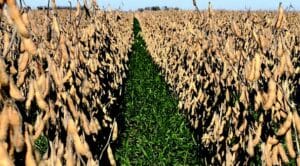Midwest Cover Crops Council (MCCC-102)
This publication is intended to provide a starting point for farmers who are new to growing cover crops. With experience, farmers may fine-tune the use of cover crops for their systems.
Introduction
Fitting cover crops into rotation can be challenging depending on which crops are grown. That challenge is further enhanced by a short growing season in this region. If you have a small grain or other short-season crop in rotation, it is easier to fit a cover crop after an early crop harvest. Farmers interested in using cover crops could consider including small grains in rotation to create that window of opportunity for cover crops when first starting this practice.
It is highly recommended that each producer identify specific goals for each field/farm and choose cover crops that can provide functions to achieve those goals. Functions and goals of cover crops for a basic recipe are described in Table 1.
Basic Starting Points for Common Crop Sequences
The following mixes are selected for North Dakota because they should be low risk for herbicide carryover injury and have a low chance for becoming weedy. The general recipe includes a grass (such as cereal rye and oats) and a brassica (most commonly radish). Producers can add flax to either if a three-species mix is desired. Recommended seeding rates for these mixes are included in Table 2.
- Spring or winter wheat–soybean: Cereal rye, radish, flax – Early fall harvest of wheat broadens options and will provide more benefit. Consider using a stripper head for wheat to leave residue standing and avoid a mat, or straight cut wheat as high as possible. Covers should be drilled immediately after field is harvested to maximize time for growth. Cereal rye, radish, and flax mixture will help manage soil moisture, cover the soil, promote infiltration, and provide food for beneficial insects. Cereal rye should be monitored closely for moisture use in the spring. If the seedbed is drying too quickly, the rye needs to be terminated. If there is excess moisture, the rye can continue to grow and soybean can be planted into the living cereal rye (called planting green). Terminate the cereal rye with a full rate of herbicide. Make sure disk openers on planting equipment are sharp to cut through residue.
- Corn-soybean: Cereal rye or barley, and radish – Given limited to no growing time following corn harvest, interseeding of corn is preferred between V5- to V8-stage corn, depending on available equipment clearance and access to the field. Broadcast or aerial seeding of cereal rye or barley, and radish will help manage water and salinity, compete with weed pressures, and promote soil aggregation. Manage corn residue both on the back of the combine and by using a non-chopping head to leave cornstalks standing. The mat of cornstalks created by a chopping head will result in wet soil conditions the following spring and cornstalks blowing across the field over winter. Cereal rye will overwinter and provide spring cover crop growth and water management.

- Soybean-corn: Barley and radish – Covers should be drilled immediately after field is harvested to maximize time for growth. Barley and radish have some cold tolerance. Having these cover crops will help reduce erosion, manage salinity, and promote infiltration. Cereal rye prior to corn is higher risk and requires specific management in the spring. Broadcasting cover crops into soybean prior to leaf drop is also an option, but this requires more experience to get timing correct to avoid possible smearing on the beans from green material.
- Soybean-soybean: Cereal rye or barley – Covers should be drilled immediately after field is harvested to maximize time for growth. Cereal rye or barley will help reduce erosion, and cereal rye will overwinter to use moisture in the spring.
Four Tips for Using Cereal Rye
- Depending on conditions, cereal rye can be seeded late into the fall, with a majority of growth occurring in the spring.
- Increase rates with later seeding dates.
- Use higher rates when broadcasting versus drilling.
- Terminate 14 days in advance of planting corn, and never use cereal rye before a wheat or barley crop.
Table 1. Functions and goals of cover crops
| Functions | Description and Goals | Cover Crops |
| Soil Builders | Crops with fibrous root systems add organic matter to the soil and build aggregation. | Cereal rye, oat, barley, triticale |
| Nitrogen Fixers | Legume crops fix atmospheric N2 by symbiotic association with soil bacteria. | Forage pea, field pea, winter Austrian pea, faba bean, clovers |
| Nutrient Capture or Release | Plants with a taproot that reaches 4-6 ft. deep capture nutrients lost from the crop rooting zone. Flax also releases P from the soil, increasing its availability. | Radish, rapeseed, flax |
| Soil Looseners | The thick taproot of brassicas reduces soil compaction and increases water infiltration. | Radish, rapeseed |
| Soil Erosion Preventer | Cereals cover the soil in late fall, and winter-hardy cereals provide soil cover and protection in the spring. | Cereal rye, barley, oat |
| Weed Suppression | Crops release allelopathic compounds, reducing the growth of weeds. | Cereal rye |
| Water Management | Winter-hardy crops use moisture early in the spring. | Cereal rye |
Table 2. Seeding rate for crops in mixes or alone
| Crop Sequence | Crops | Planting Method | Seeding Rate* (lbs./acre) |
| Wheat-soybean | Cereal rye, radish, flax | Drill | 30, 2, 2 |
| Corn-soybean | Cereal rye or barley, and radish | Aerial broadcast | 50 or 50, 2 |
| Soybean-corn | Barley, radish | Drill | 30, 2 |
| Soybean-soybean | Cereal rye or barley | Drill | 30 or 30 |
*These seeding rates are based on high-quality seed with germination rates of 85-98% and purity >90%.
Resources
North Dakota State University Soil Health
Midwest Cover Crops Council: North Dakota
Cover Crop Selector Tool — available from the Midwest Cover Crops Council
Authors
Abbey Wick, Department of Soil Science, North Dakota State University, email: [email protected]; Marisol Berti, Department of Plant Sciences, North Dakota State University, email: [email protected]; Lee Briese, Centrol Crop Consulting, Jamestown, ND, email: [email protected]
Reviewers and Contributors
Shalamar Armstrong, Purdue University; Tom Kaspar, USDA–Agricultural Research Service (retired); Eileen Kladivko, Purdue University; Anna Morrow, Midwest Cover Crops Council; DeAnn Presley, Kansas State University; Vaughn Sothman, Sharp Brothers Seed Co., Kansas; Anne Verhallen, Ontario Ministry of Agriculture, Food and Rural Affairs
The Midwest Cover Crops Council (www.https://www.midwestcovercrops.org) aims to facilitate widespread adoption of cover crops throughout the Midwest by providing educational/outreach resources and programs, conducting new research, and communicating about cover crops to the public.
Funding for this project was provided by McKnight Foundation.
Revised November 2018
The U.S. Department of Agriculture (USDA) prohibits discrimination in all its programs and activities on the basis of race, color, national origin, age, disability, and where applicable, sex, marital status, familial status, parental status, religion, sexual orientation, genetic information, political beliefs, reprisal, or because all or a part of an individual’s income is derived from any public assistance program. (Not all prohibited bases apply to all programs.) Persons with disabilities who require alternative means for communication of program information (Braille, large print, audiotape, etc.) should contact USDA’s TARGET Center at (202) 720-2600 (voice and TDD). To file a complaint of discrimination write to USDA, Director, Office of Civil Rights, 1400 Independence Avenue, S.W., Washington, D.C. 20250-9410 or call (800) 795-3272 (voice) or (202) 720-6382 (TDD). USDA is an equal opportunity provider and employer. ©2018 by MCCC. All rights reserved.
